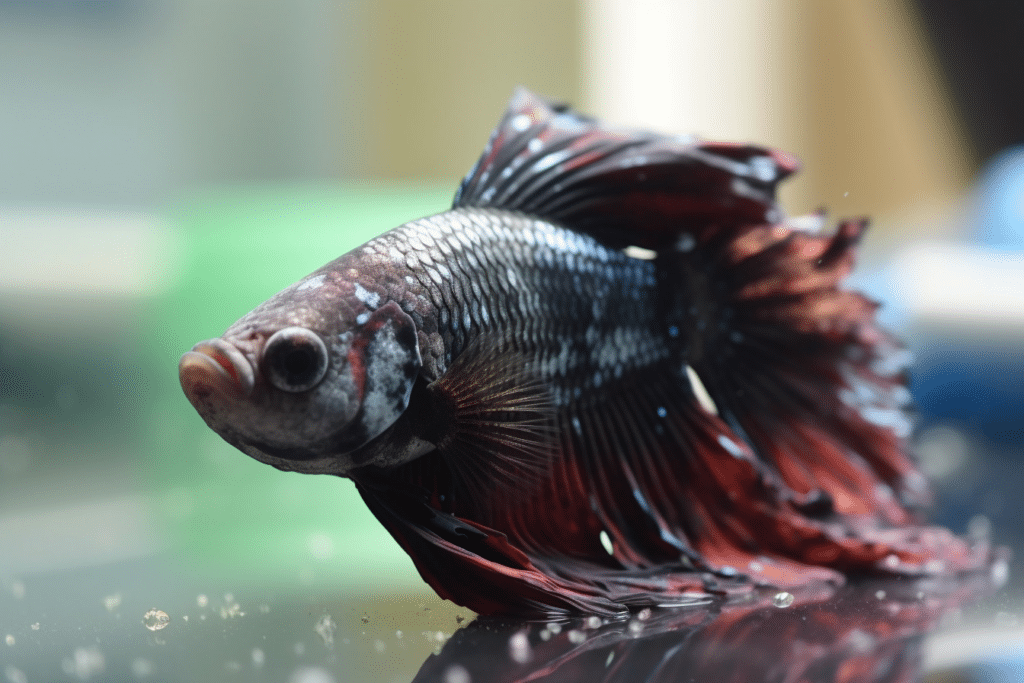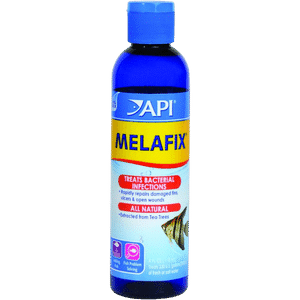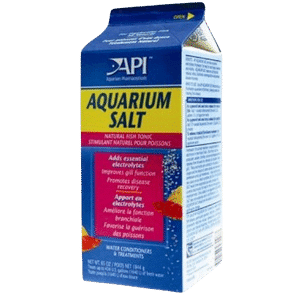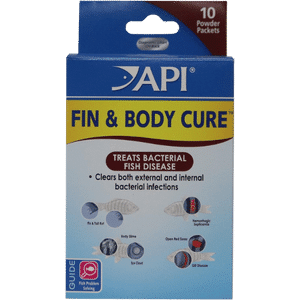Betta Fin Rot: Expert Strategies for Effective Treatment and Prevention
While discussing Betta fin rot may not be the most pleasant topic, it is essential for any Betta fish owner to understand the symptoms, causes, and treatments.

When you equipped with the correct information, Betta fin rot can be successfully treated, and in many cases, even prevented. The key lies in understanding the disease itself, its causes, symptoms, and effective treatments.
This guide will serve as your comprehensive resource, providing the necessary tools to navigate this challenge. From recognizing the early signs of fin rot to implementing preventative measures, we’re here to support you in ensuring your pet fish leads a healthy, thriving life.

Medical Disclaimer: The information provided in this article is for educational purposes only and is not intended to replace professional veterinary advice. Always consult with a qualified veterinarian for any health concerns or treatments related to your pet. Your veterinarian can provide diagnoses and appropriate treatment options tailored to your pet’s specific needs.
A Quick Heads-Up… If you come across links on this page that take you to products on Amazon Associate or other partner stores, they’re affiliate links. This means if you decide to make a purchase, BettaReef earns a commission, but at no extra cost to you.

Table of Contents 🦑

Betta Fin Rot Definition
Betta fin rot, also known as Betta tail rot or Betta fin melt, is a bacterial or fungal infection that affects the fins and tails of the fish, causing them to discolor, and eventually decay.
This condition often presents itself as ragged, disintegrating fins with a distinct white or milky edge. If left untreated, fin rot can progress to the body of the fish, potentially leading to severe health issues and even mortality.
While fin rot can affect any fish, Betta fish, with their large, delicate fins, are particularly sensitive.
7 Signs and Symptoms of Betta Fin Rot
Recognizing fin rot in its early stages is essential for successful treatment. Like many illnesses, the earlier it’s detected, the higher the likelihood of your Betta fish making a full recovery.
Fin rot, particularly in its beginning stages, can be subtle, but only with careful observation, you can notice the signs and take necessary action promptly.
The changes fin rot causes to a Betta’s appearance are distinct, making the disease somewhat easier to identify if you know what to look for.
Let’s delve into the main seven detailed symptoms and signs of fin rot that will help you recognize if your Betta fish might be affected.
1. Fraying Fins
One of the earliest signs of fin rot is frayed fins. The edges of the Betta fish’s fins start to look tattered or ripped. Initially, these changes might seem minor, but they can quickly progress if the cause of the condition isn’t addressed.
2. Fading Color
The affected areas of the fins may start to fade or lose their vibrant color. This color loss typically starts at the edges of the fins, gradually working its way toward the base if left untreated.
3. White Edges
Fin rot can cause the edges of your Betta fish’s fins to turn white or pale. This is often a result of the bacterial or fungal infection that’s causing the fin to rot.
4. Black or Red Edges
In some cases, the edges of the fins might turn black or red instead of white. This usually indicates a more severe or advanced case of fin rot.
5. Fin Reduction
As fin rot progresses, the fins will start to shorten or become progressively smaller. This is because the bacteria or fungi are eating away at the fins.
6. Inactive or Passive Behavior
Betta fish suffering from fin rot may exhibit changes in behavior such as decreased activity levels or lethargy. While this could also indicate other health issues, combined with changes to the fins, it can point to fin rot.
7. Loss of Appetite
Like many illnesses, fin rot can lead to a decreased appetite in Betta fish. If your Betta is not eating as usual and showing other signs of fin rot, it is time to take action.
By recognizing these symptoms early and initiating appropriate treatment, you can halt the progression of fin rot and start the healing process for your Betta fish. Remember, attention and quick action are the keys to managing this condition effectively.


10 Potential Causes of Betta Fin Rot
Fin rot in Betta fish can be attributed to numerous factors, many of which are often related to the quality of their living conditions.
This condition primarily stems from bacterial or fungal infections that take hold when a fish’s immune system is compromised. Unfortunately, once it starts, fin rot can progress rapidly if not addressed promptly and correctly.
Fin rot may begin as a minor issue, but it can lead to severe consequences if left untreated. Understanding its causes is key to prevention and early detection. Below, we delve into ten potential causes of fin rot in Betta fish.
1. Injuries
Physical injuries to the fins from sharp or rough objects in the tank or fights with other fish can be a starting point for fin rot. Any wound or tear in the fins can get infected by opportunistic bacteria present in the water, leading to fin rot.
2. Poor Water Quality
Water quality is crucial for the health of any aquarium fish, including Bettas. Poor water quality, characterized by high levels of pH, ammonia, nitrites, and nitrates, can stress Bettas, weakening their immune system and making them susceptible to diseases like fin rot. Regular water changes and adequate filtration are necessary to maintain a clean and healthy environment.
3. Bacterial Infection
The primary culprit behind fin rot in betta fish is often a gram-negative bacterium called Pseudomonas fluorescens. This bacterium can infect even the smallest wound on a betta, and if left untreated, the situation can worsen rapidly.
Notably, this bacterium thrives in warm water, which coincidentally is the ideal environment for bettas, making vigilance and prompt treatment essential.
4. Fungal Infection
While less common, fungal infections can also lead to fin rot in bettas. Characterized by white, fluffy growths, fungal infections can exacerbate fin rot symptoms, leading to what is often referred to as ‘fin melting.’ This type of infection can occur alongside other symptoms of fin rot, necessitating comprehensive treatment approaches
5. Incorrect Water Temperature
Betta fish are tropical fish and require warm water between 76 and 82 degrees Fahrenheit (24 – 28°C). Water temperatures below this range can lead to a sluggish immune response, making Bettas more prone to diseases like fin rot.
6. Poor Nutrition
A balanced, nutritious diet is necessary for keeping Betta fish healthy and boosting their overall health. A diet low in essential nutrients can lead to a weakened immune system, making Betta fish more vulnerable to diseases, including fin rot.
7. Ineffective Filtration
A good filtration system helps remove waste products and toxins from the water, maintaining a healthier environment for your Betta fish. Without adequate filtration, the buildup of waste can lead to harmful water conditions and increased chances of diseases like fin rot.
8. Overcrowding
Overcrowding in a tank can lead to increased waste and toxin levels, and deteriorating water quality can increase the likelihood of disease spread, including fin rot.
For a community tank, it requires a minimum of a 10-gallon tank. Providing plenty of space for your Betta fish aids in maintaining a healthier environment.
9. Stress
Stress is a significant factor that can weaken a Betta fish’s immune system, increasing the susceptibility to illnesses like fin rot. Stress can be caused by various factors, including poor water conditions, aggressive tank mates, constant disturbance, or rapid changes in water parameters.
10. Overuse of Medications
While medications can be necessary to treat illnesses, their overuse can disrupt the balance of beneficial bacteria in the fish tank, leading to poor tank water quality. Additionally, some Betta fish might have adverse reactions to certain medications, leading to stress and a higher susceptibility to diseases like fin rot.
Recognizing these potential causes and working towards preventing them is key in reducing the risk of fin rot in your Betta fish. With good care and diligent monitoring, you can ensure your Betta fish stays healthy and vibrant.


Diagnosing Fin Rot in Betta Fish
When it comes to diseases like fin rot, an accurate diagnosis is the cornerstone of effective treatment.
With a multitude of diseases that can affect Betta fish, each with its unique signs and symptoms, it’s important to correctly identify the problem to administer the right treatment. Misdiagnosis not only delays the correct intervention but can also worsen the situation.
Furthermore, an accurate diagnosis of fin rot helps in understanding the underlying causes of the condition in your specific case. This understanding aids in future prevention strategies and promotes overall better care for your Betta fish. Now, let’s look at the step-by-step process for diagnosing fin rot in your Betta fish.
Observation
The first step in diagnosing fin rot involves carefully observing your Betta fish. Look for the signs and symptoms we discussed previously like fraying fins, color changes, lethargy, and appetite loss.
Close Examination
Sometimes, early signs of fin rot may not be easily noticeable at a glance. Therefore, a close, detailed examination of your Betta fish’s fins is necessary. Look for slight changes in the edges and color of the fins.
Compare with Healthy State
If you’re familiar with how your Betta fish’s fins usually look, compare their current state with that healthy state. This comparison can reveal subtle changes that might not be obvious otherwise.
Tank Condition Check
Fin rot is often a result of poor water conditions. Checking the water parameters, like temperature, pH, and cleanliness, can help in the diagnosis process. A tank with high levels of pollutants often leads to diseases like fin rot.
Behavioral Assessment
A Betta fish suffering from fin rot will often show changes in behavior, like reduced activity and loss of appetite. Monitor your Betta fish’s behavior and eating habits to assess for these changes.
Consultation with a Vet
While you can do a preliminary diagnosis based on observation, consulting with a vet or aquarium professional can provide a more definitive answer. If you notice persistent symptoms or your Betta fish’s condition seems to worsen, seek professional help.
This step-by-step process will help you accurately diagnose betta fin rot. Remember, early diagnosis is key to effective treatment and enhancing the likelihood of your Betta fish’s complete recovery.

How to Treat Betta Fin Rot
Prompt and appropriate treatment is crucial for betta fin rot, as delays can lead to severe deterioration, impacting the fish’s health and potentially being fatal.
Early intervention improves recovery chances. Additionally, treating fin rot promptly is vital for the health of the entire aquarium, as the condition can spread to other fish.
Treatment options vary from improving water conditions and using over-the-counter medications to natural remedies and, in serious cases, veterinary care.
Water Change
Begin treating betta fin rot by changing half of the tank’s water with fresh, treated tap water that’s free of chlorine. During this process, use a gravel vacuum to thoroughly clean the substrate, removing any leftover food, waste, and debris.
If you have a filtered tank, make sure to clean the filter in the tank itself to maintain beneficial bacteria, and replace any outdated filter media.
Maintain the tank’s health with regular 25% water changes, continuing to keep a close eye on water conditions.
Aquarium Salt Treatment
Aquarium salt, not to be confused with table salt, can be beneficial in treating betta mild fin rot. The salt aids in healing the damaged fins and helps to prevent secondary bacterial infections. However, it’s crucial to use the right dosage as an excess of salt can be harmful to Betta fish.
Antibacterial Medications
Over-the-counter antibacterial medications are available in most pet stores and can effectively treat betta fin rot.
Medicines like Kanaplex, Maracyn-2, and Furan-2 are often recommended. Always follow the instructions on the medication package to ensure proper treatment, above all, don’t forget to check that whatever you’re adding is meant for freshwater buddies, not for saltwater fish, alright?!.
Treats body slime, eye cloud, fin and tail rot, open red sores, gill disease, and hemorrhagic septicemia
Maintain a Clean Fish Tank
Maintaining a clean fish tank is essential for the health of your Betta fish. It’s not just about keeping the water sparkling clear, it’s about ensuring the environment is free from harmful bacteria and excess waste, and uneaten food.
Regularly check your water parameters to make sure they’re in the ideal range for Bettas, and stay on top of routine water changes.
Don’t forget to clean the substrate and any decorations or plants in the tank as well, as slime can build up there. Remember, a clean tank equals a happy and healthy Betta!
Natural Remedies
Some aquarists swear by natural remedies like Indian Almond Leaves, which are believed to have antibacterial properties. These leaves can be added to the aquarium water to help in the treatment of betta fin rot.
Superb for the health of your betta fish, Best way to create a natural and tropical environment
Quarantining Infected Fish
If you have a community tank, it’s advisable to place the affected Betta fish in a quarantine tank during the treatment process. This measure helps to prevent the disease from spreading to other fish.
Dietary Changes
Incorporating high-quality, nutritious fish food in your Betta’s diet can boost their overall health and aid in recovery. A healthy diet can enhance your Betta fish’s ability to fight off the infection.
Veterinary Intervention
In severe fin rot cases or if the condition does not improve with initial treatments, consult a vet. They may prescribe stronger medications or treatments based on the condition of your Betta fish.
Regular Monitoring
During and after the treatment, regularly monitor your Betta fish fin and the water conditions. Regular monitoring will help you catch any recurring signs of betta fin rot and intervene promptly.
The best treatment for fin rot depends on various factors, including the severity of the condition and the overall health of your Betta fish. Consult with an aquatic veterinarian if you’re unsure about the best course of action.

Preventing Fin Rot in Betta Fish
Preventing fin rot in Betta fish begins with understanding that prevention is always better than cure.
This adage holds incredibly true in the aquarium hobby as it is often simpler and less stressful for both the pet owner and the fish to avoid diseases rather than having to treat them.
Prevention of fin rot in particular does not demand any overly complicated procedures or equipment. Rather, it mostly involves providing your Betta fish with a consistently clean and healthy living environment.
The significance of prevention strategies cannot be overstated. Good preventive measures not only keep your Betta fish safe from fin rot but also other potential diseases.
By sticking to the preventive strategies, you are essentially maintaining the overall health and immunity of your Betta fish, therefore extending its life span and enhancing its color and vibrancy.
Frequently Asked Questions About Betta Fish Fin Rot
Q: What Exactly is Betta Fin Rot?
A: Fin rot is a common bacterial or fungal infection that affects the fins of fish, causing them to look ragged and deteriorated. If left untreated, it can progress to the body of the fish and potentially prove fatal.
Q: Is It Possible For The Fins of a Betta Fish to Regrow?
A: Yes, betta fish fins can regrow under the right conditions.
If your betta fish has fin rot or its fins become damaged, they can regrow over time, assuming the damage is not severe, and the appropriate measures are taken.
This includes providing optimal water quality, a healthy diet, and any necessary treatments to fight off infection.
However, it’s important to remember that severe fin rot or recurrent damage can lead to permanent tissue loss or change the way fin regrowth back. Thus, prevention of injury and disease is crucial.
Q: What Causes Fin Rot in Betta Fish?
A: Betta Fin rot is usually caused by poor water conditions, stress, injuries, overcrowding, and underlying health issues. Bacteria and fungi thrive in unclean water, making it a major culprit for this disease.
Q: What are The Symptoms of Fin Rot in Betta Fish?
A: Symptoms of betta fin rot include frayed or torn fins, discoloration along the edges of the fins, loss of appetite, and lethargy, and if the disease progresses, it can cause the fins to fall off completely.
Q: How is Fin Rot Diagnosed in Betta fish?
A: Diagnosis is mainly done through visual inspection of the Betta fish. If you notice any symptoms of fin rot, it’s crucial to start treatment as soon as possible.
Q: How Can I Treat Fin Rot in My Betta Fish?
A: Treatment involves improving water conditions, administering antibacterial or antifungal medications, and sometimes antibiotic baths. It’s crucial to isolate the affected fish to prevent the spread of the disease to other tank mates.
Q: How Long Does it Take for Betta Fish to Recover From Fin Rot?
A: With proper treatment and care, you can expect to see improvements in your Betta fish’s fins within a week or two. However, full recovery might take several weeks or even months depending on the severity of the condition.
Q: Can Betta Fish Fully Recover From Fin Rot?
A: Yes, Betta fish can fully recover from fin rot with proper and timely treatment. Once recovered, their fins can regrow, although they may not look the same as before.
Q: Can Fin Rot Spread to Other Fish?
A: Yes, fin rot can be contagious, especially in conditions of poor water quality. Therefore, it’s crucial to isolate the affected fish and treat the whole tank.
Q: How can I Prevent Fin Rot in My Betta fFish?
A: Maintaining optimal water conditions, not overcrowding the tank, feeding a balanced diet, managing stress levels, and regularly checking for signs of illness are key preventative measures.
Q: What Should I Do if My Betta Fish's Fin Rot Isn't Improving?
A: If you don’t see any improvement despite your best efforts, it’s best to consult a vet or an aquatic specialist. There might be underlying issues that are complicating the recovery.
Q: Is Fin Rot Painful for Betta Fish?
A: While it’s hard to definitively say if fish experience pain the same way humans do, diseases like fin rot are likely to cause discomfort and stress to Betta fish.
Q: Can I Use Tap Water For My Fish Tank?
A: Tap water can be used for a betta fish tank, but it’s important to treat it first to make it safe for your fish. This is because tap water often contains chlorine, chloramines, and heavy metals, which are harmful to fish.
You can treat the water by using a water conditioner or de-chlorinator, which is readily available at pet stores and online. These products work by neutralizing harmful substances.
We hope this FAQ section helped answer some of your questions about fin rot in Betta fish. Remember, maintaining a healthy and clean environment for your fish is the key to preventing diseases like fin rot. If you notice any signs of illness, don’t hesitate to take action.

Inconclusion
Understanding fin rot in Betta fish is vital not only for the health and well-being of your fish but also for the overall vitality of your aquarium environment. This disease serves as an indicator of underlying issues in your aquarium’s ecosystem, such as poor water quality, stressors, or inadequate nutrition.
By understanding what fin rot is, its causes, and its symptoms, you can promptly identify and address these issues, preventing the spread of the disease to other fish and preventing more serious health complications.
Moreover, recognizing and addressing fin rot early contributes to the longevity and quality of life of your fish.
As a Betta fish owner, understanding the details of this common ailment empowers you to provide a secure, healthy environment for your aquatic pet. Knowledge of fin rot and its management equips you to act swiftly, ensuring the issue is handled effectively and minimizing the potential distress and harm to your beloved Betta.


Delighted to have you here at BettaReef! This place is a treasure trove of knowledge about Betta fish, Betta Care, Health, Gear, and much more from the wonders of aquatic life. My journey in this fascinating world began when I was just 8, and now, as a seasoned hobbyist, I’m here to help fellow Betta enthusiasts create a thriving Betta environment for a healthy life.
I’m committed to delivering high-quality content, backed by a stringent editorial process. Each product review is based on real-life usage and practical analysis, ensuring that you get insights and advice that truly matter.

Related Blog Posts:

Betta Fish Poop Health Secrets
Swim To 🤿 Home Betta Fish Poop Health Secrets Betta Fish Poop, An Indicator of

Betta Fish Dropsy
Betta Fish Dropsy Best Cure and Prevention Tips! Betta Fish Dropsy, Recognize the symptoms, understand

Betta Fish Bloat
Betta Fish Bloat Causes, Treatment, and Prevention Tips Explore effective treatments and prevention strategies for




